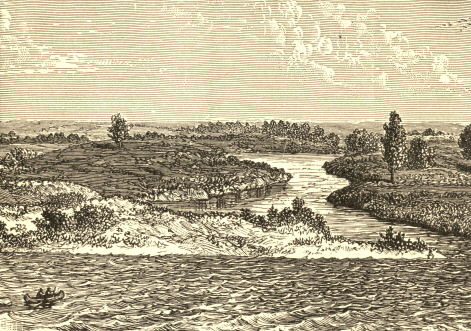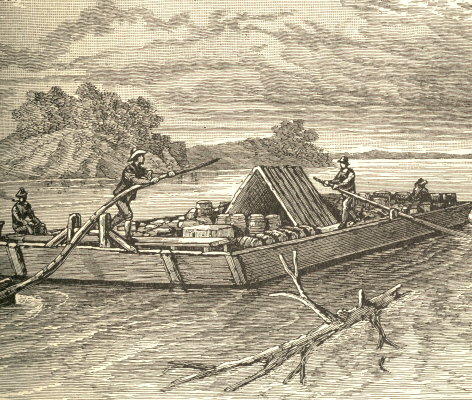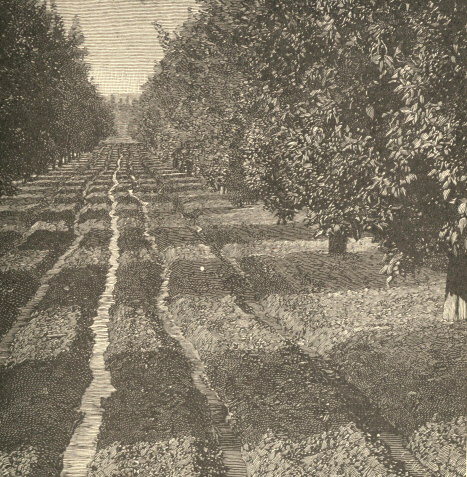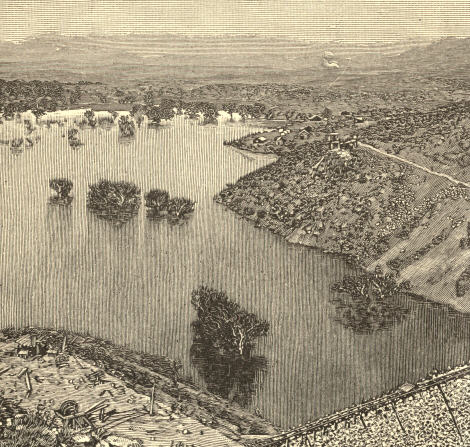1868-1888 Chapter V THE WEST
CHAPTER V.
THE WEST
Aside from West Virginia, made during the war from the loyal part of Virginia, the new States created between 1860 and 1900 were Kansas, 1861; Nevada, 1864; Nebraska, 1867; Colorado, 1876; North Dakota, 1889; South Dakota, 1889; Montana, 1889; Washington, 1889; Idaho, 1890; Wyoming, 1890; and Utah, 1896. The whole number of States had thus become forty-five. We had also, in the year 1896, three organized territories, Arizona, New Mexico, and Oklahoma, the last carved out of Indian Territory in the year 1890. Alaska was as yet a partially organized territory, having no territorial legislature, and being under the laws of the United States and of the State of Oregon. It was purchased by the United States from Russia in 1867, for the sum of $7,200,000. It remained without any organization until the act of May 17, 1884, which gave it a governor, a district court, an attorney, a marshal, and commissioners.

The Site of Chicago.
The value to our Union of this new acquisition, with its 531,409 square miles and a coast-line longer than that upon our Atlantic and Gulf coasts together, was at first doubtful, and continued so till gold was found on the Yukon and at Cape Nome. Clearly, however, the money had not been thrown away.
Governor Swineford, appointed over the Territory in 1885, declared that throughout Southern Alaska and the Aleutian Islands the climate was moderate, even in winter; and he gave records of thermometrical observations which seemed to prove this. He further maintained that, in the parts named, all our hardier plants and crops grew to maturity in summer, and attained extraordinary luxuriance. In 1890, 4,298 white people had homes in Alaska, besides 1,823 mixed, 23,531 Indians, and 2,288 Mongolians, a total population of 32,052.
The Alaska Commercial Company paid the United States $55,000 yearly for its monopoly of the Alaska seal-fur trade. The product of this business was about $2,500,000 each year. An official report made to our Government stated that in the year 1880, $2,181,832 worth of Alaska furs found sale in London alone. Coal had been discovered in various places. So had beautiful white marble. Gold-bearing ledges were numerous, and the only one of these yet broached, that on Douglas Island, had certainly yielded well.
The mill connected with it, working only the equivalent of two-thirds time, turned out during its first twelve months a little over $750,000 worth of gold bullion. For the year 1889, according to imperfect returns, the product from this remote patch of our national domain was as follows: Seal fisheries, $314,925, a falling off of over 80 per cent. in nine years; other fisheries, $1,059,365, an increase of about 100 per cent. for the same period; 43,762 troy ounces of gold and 9,219 troy ounces of silver. In 1890 there were ten manufacturing establishments, whose product amounted to $58,440.
After 1860 there was a steady filling up of the Pacific coast, and an equally continual extension of population to the west on the east side of the Rockies. All Iowa was in cultivation, and all Minnesota but the extreme northwest corner. In fifteen years the rate of interest went down in Iowa from ten to seven or eight per cent., in Michigan from ten to six or seven per cent. Chicago, from being only a borrower of money, grew to be an immense lender for enterprises in the West. Settlement in Kansas, Nebraska, and Texas rolled westward with strength and rapidity. Some of the finest new towns in these States were well toward their far western border.

An Ohio River Flat-Boat.
The construction of the five great Pacific railway lines, the Northern, the Union, the Santa Fe, the Southern, and the Great Northern, with their various branches, brought into valuable employ infinite reaches of fertile land previously as good as desert. Texas made most remarkable advance both in square miles occupied and in density of population, brought about by great extension of railway mileage, and of cattle, sheep, and wheat culture. Large patches of the Dakotas, Montana, and Idaho filled with settlers. Colorado became a giant in production, the rush of population thither in consequence of very extensive and rich mineral discoveries having been a stampede almost like that of 1849-50 to California. Every hill was black with miners. The growth of New Mexico, Arizona, and Nevada, considering their natural wealth, was slow, owing in part to Indian hostilities. New Mexico fell from rank 37 in 1870 to rank 43 in 1890. Tucson, Ariz., according to the best figures, fell between 1880 and 1887, from 10,000 to 7,500 inhabitants. In material things Utah prospered greatly under the thrift, economy, and hard work of the Mormons. Here mining and speculation were less rigidly pressed, and more energy devoted to agricultural pursuits.

An Irrigated Orange Grove at Riverside, California.
In California, a smaller proportion than formerly of all industry was now applied to mining, a larger to agriculture and cattle-raising. Southern California became the competitor of Florida as a winter residence. Oregon and Washington vied with Minnesota for the world-medal in wheat culture. Over the infinite pasture lands at both feet of the Rocky Mountains roamed herds of bullocks destined to feed distant cities in America and in Europe. It was foreseen that many of these lands would in the course of time be ploughed, and by the aid of irrigation turned into corn-fields, wheat-fields, and market-gardens, a process which in New Mexico had already gone far. Even the tract inclosed by the parallels 31 and 45 degrees and the meridians 100 and 120 degrees, which long seemed destined for perpetual sterility, spite of the many enterprises conceived, and the others, like the scheme of the Colorado River Irrigation Company, initiated for redeeming it, grew valuable when it was believed that the National Government would undertake to irrigate there. Crops in that region grew bountifully under irrigation, and permanent water-supplies could easily be created.
Natural woodland existed there only near the few streams, and of the scanty trees which grew scarcely a single variety of hard wood was found; but the state and national afforestation of vast tracts bade fair to change this. The region comprised in the States and Territories named was not only the richest precious-metal field in America, but one of the very richest on the globe.
The picture we have presented is too glowing for the year 1893-94, during which great depression afflicted the whole West; but this was only temporary. Recovery was indicated by the success of the Trans-Mississippi Exposition at Omaha, in 1898. There were 2,600,000 admissions. The total cash receipts were $1,761,364, and the stockholders in the enterprise were paid dollar for dollar.
The city of San Francisco had 500 inhabitants in 1840, 34,776 in 1850, 56,802 in 1860, 149,473 in 1870, 233,959 in 1880, 298,997 in 1890. This progress may be taken as in some sense an index to that of the West as a whole, far more so than the apparently spasmodic increase in some of California's smaller centres.
Los Angeles mounted from a population of 5,728 in 1870, and of 11,183 in 1880, to one of 50,395 in 1890. Oakland had but 10,500 in 1870. Ten years later the figure was 34,555; and in 1890 it was 48,682. Stockton leaped from 10,287 in 1880 to 14,424 in 1890. In 1858 Denver was uninhabited. In 1870 it numbered 4,759 souls; in 1880, 35,629; in 1890, 106,713. Portland, Oregon, had in 1890, 46,000 inhabitants; in 1900, 90,000. In the decade 1880-90 Wyoming grew from 20,789 to 60,705.
The growth and prosperity of this great western section of our country become apparent from an inspection of the following table, compiled from authentic sources:
Population. Property valuation. $ Value of Farms. $
STATES. 1870. 1890. 1880. 1890. 1880. 1890.
California 560,247 1,208,130 1,343,000,000 2,533,733,627 262,051,262 697,116,630
Colorado 39,864 412,198 240,000,000 1,145,712,267 25,109,223 85,035,180
Dakota, Total 14 181 118,000 000 22,401,084
Dakota, North ,719 337,006,506 75,310,805
Dakota, South 328,808 425,141,299 107,466,335
Idaho 14,999 84,335 29,000,000 207,896,591 2,832,890 17,431,560
Kansas 364,399 1,427,096 760,000,000 1,799,343,501 235,178,936 559,726,046
Minnesota 439,706 1,301,826 792,000,000 1,691,851,927 193,724,260 340,059,470
Montana 20,595 132,159 40,000,000 453,135,209 3,284,504 25,512,340
Nebraska 122,993 1,058,910 385,000,000 1,275,685,514 105,932,541 402,353,913
Nevada 42,491 45,761 156,000,000 l80,323,668 5,408,325 12,339,410
New Mexico 91,874 153,593 49,000,000 231,459,897 5,514,399 8,140,800
Oregon 90,923 313,767 154,000,000 590,396,194 56,906,575 115,819,200
Texas 818,579 2,235,523 825,000,000 2,105,576,766 170,468,886 399,971,289
Utah 86,786 207,905 114,000,000 349,411,234 14,015,178 28,402,780
Washington 23,955 349,390 62,000,000 760,698,726 13,844,224 88,461,660
Wyoming 9,118 60,705 54,000,000 169,773,710 835,89514,460,880
TERRITORIES
Alaska 32,052
Arizona 9,658 59,62041,000,000 188,800,976 1,127,946 7,222,230
Rail Mileage Periodicals Gold Troy Oz. Silver Troy Oz.
1885.1890. 1880. 1893. 1880. 1889. 1880 1889.
California3,044 4,356 364 639 829,677 608,382 890,158 1,062,578
Colorado2,884 4,176 90 298 130,608 187,881 12,800,120 18,375,551
Dakotas2877 66 159,920 54,770
North Dakota2,003 139
South Dakota2,470 269 149,538 104,672
Idaho 944 8 58 71,578 95,983 359,309 3,137,508
Kansas4,441 8,306 349 759
Minnesota4,331 5,379 224 558
Montana1,047 2,181 18 90 87,354 151,861 2,246,938 13,511,455
Nebraska2,988 5,300 189 645
Nevada 945 924 37 26 236,469 169,617 9,614,561 4,696,605
New Mexico1,195 1,324 18 59 2,387 39,457 303,455 1,251,124
Oregon1,181 1,433 74 194 53,101 46,648 21,496 17,851
Texas6,687 8,630 279 678 330 323,438 829,438
Utah1,085 1,085 24 71 14,105 23,591 3,668,566 7,005,193
Washington 736 1,774 29 253 6,569 9,005 789 23,464
Wyoming 617 941 10 43 838 711
TERRITORIES
Alaska 4 238 43,762 39 9,219
Arizona 906 1,096 17 35 10,254 44,029 1,738,921 1,812,961

The Irrigating Reservoir at Walnut Grove, Arizona,
showing the Artificial Lake partly filled.
We shall be pardoned for recurring again to Minnesota. So recently as 1838, where St. Paul and Minneapolis now stand, the former with a population in 1890 of 133,156, the latter with one of 164,738, not a white man's abode had risen. There were then but three cabins between St. Paul and Prairie du Chien, a distance of 300 miles down the Mississippi.
Summit Avenue, St. Paul, was, in 1890, the finest street in America, if not on the globe. West St. Paul, in 1880 a hamlet of a few huts, had by 1890 20,000 to 30,000 people, with street-cars, large business blocks, fine houses and stores. The pioneer railway in Minnesota was laid in 1862, from St. Paul to St. Anthony, the first shovelful of earth being lifted by a citizen of St. Paul, who probably lived to see his State gridironed with 5,379 miles of track; his own firm constructing over 1,100 miles in the single year 1887. Minneapolis in 1887 turned out 5,000,000 barrels of flour, an average of 100,000 barrels a week.
Duluth had in 1880 but 3,740 people. In 1890, 33,115. The cause of Duluth's advantage is obvious upon a glance at the map. It is by water no farther from Lake Erie than Chicago is, while it is some hundreds of miles nearer the great wheat-field. It is itself the very gate of this--the gate of Minnesota--which in 1869 brought forth 18,000,000 bushels; in 1886, 50,000,000 bushels. To this enormous yield, that of the Dakotas, about the same, had now to be added, the one as the other finding its way out to the hungry world largely through Duluth.
The caravans of people necessary to populate these immense western ranges were to a very great extent immigrants from Europe. The census of 1880 gave us 6,679,043 inhabitants of foreign nativity. We have no figures for the exact proportion of the total immigration into the country which found its home in the West, yet a glimpse at the total from year to year is interesting at this point. The falling off in and after 1893 is particularly noticeable. Immigrants arrived as follows:
In


